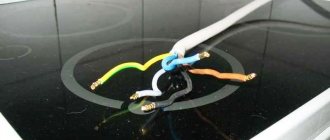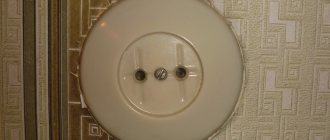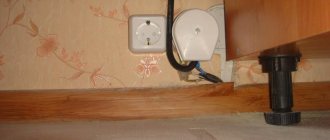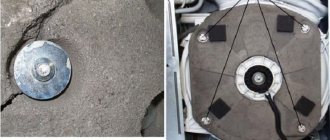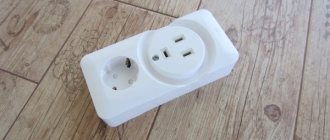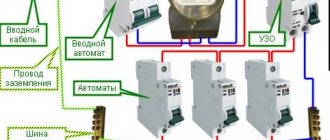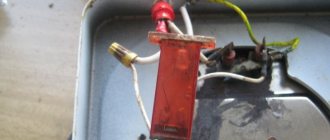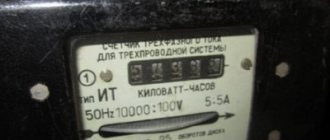Modern ovens are multifunctional tools for cooking a variety of dishes from meat, fish, cereals, vegetables and fruits, as well as dough. In the hands of an experienced housewife, the oven can be used for defrosting and heating food, preparing semi-finished products and homemade baked goods, and maintaining the temperature of ready-made dishes. A good oven will help you realize any culinary fantasies and please your family and friends with something delicious.
The market offers a huge number of solutions from different manufacturers. Gas and electric ovens continue to be in demand. The latter are considered more functional and safe, although cooking with electricity is a little more expensive than with gas. When an oven breaks, it always becomes an unpleasant surprise for the user. Usually the owner puzzles over the question: is it worth repairing the appliance, or is it better to immediately order a new oven?
Power circuit breakers
Equipment malfunctions are often accompanied by failure of electronic components operating under voltage. Symptoms of a breakdown can be different: unstable operation and spontaneous shutdown of the device, the smell of burnt wiring (plastic), the appearance of clicks and sparks. If the wiring is damaged, current can flow through the metal body of the device, which poses a serious threat to the health and life of the owner. To protect users, power circuit breakers are provided for each connection line.
There are a large number of protective devices that respond to electrical equipment failures. They are triggered by a short circuit or by detecting alternating and pulsating leakage currents. Automatic circuit breakers (circuit breakers) instantly disconnect the line in the event of an overload. Residual current devices (RCDs) disconnect the circuit when a current difference is detected in the phase and neutral conductors. The difference is a signal that part of the current goes to the ground or to the protective conductor. This may indicate a violation of the integrity of the wiring or a breakdown of the equipment connected to it.
Automatic switches controlled by differential current (difavtomats) are the most complex and multifunctional devices. They provide comprehensive protection against current leakage, short circuits and network overloads. To ensure reliable protection of a person and his home, as well as wiring and household appliances, circuit breakers must be installed for each powerful consumer (refrigerator, hob, oven, water heater, washing machine and dishwasher). This disconnection will reduce the risk of failure of all devices if a short circuit occurs in one of them.
The oven knocks out the automatic switches when the convection is turned on: reasons
The power switch may trip immediately when the oven is turned on, which will indicate a short circuit. If the RCD or automatic circuit breaker is triggered after some time, we are talking about a current leak or a short circuit on a specific part that is starting to work at the moment. The convection function is a built-in fan that ensures uniform heat distribution in the working chamber using airflow. The convection fan is not activated in all programs, but it is always turned on in the “Convection” and “Grill” modes. Thus, when using the “Grill” program, the activation of the RCD will be a sign of a breakdown of the convection fan or the upper heating element (the grill itself).
If the device knocks out the machines when trying to start the “Convection” mode, this almost 100% means the fan is faulty. The reason most often is the burnout of the electric motor, which leads to current leakage or short circuit. Triggering of the power switch when starting any programs with a blowing function may also indicate a breakdown of the convection. A failed fan (with a burnt out motor) must be replaced; usually, after a short circuit, it is not possible to restore the functionality of the part.
The stove goes out after turning on the oven, fix
It happens that the hob of an electric stove works quite well, but immediately goes out as soon as the oven turns on. There are not many reasons for this behavior of the equipment, and I will talk about all of them below.
The oven itself is faulty
Simply put, the oven shorts out, which knocks out the machine, and therefore the entire stove does not work. The reasons for a short circuit can be different and more on this below. If this happens, the device is immediately disconnected from the network. Next, you need to check the wiring for damage.
Poor contact insulation
This leads to the contact of the contacts with each other or in a certain area with the metal parts of the housing. It is necessary to restore the insulation or replace the wires. For a complete check, it is worth inspecting the condition of the insulation and the contacts of all wires, including the power switch and backlight socket.
The wiring on the heating element is worn out
Most often, during long-term operation, a burnt-out phase wire comes off the heater. It comes into contact with the metal case, as in the previous case, this leads to a short circuit. The solution is to strip and fix the wire to the heating element. It makes sense to check all the wires going to the oven heater to avoid a recurrence of the problem.
Additionally, you can check the heater itself for breakdown; perhaps it itself is damaged. In practice, it happens that the cause of problems is improper storage of equipment. If condensation gets on the heating elements and they are wet, the stove will turn off. Usually the heaters are dried by turning on the device for about five hours.
The control module is faulty
Electronic filling with control functions is an integral attribute of almost any electric stove. If there is a fault, this also leads to a short circuit. Repair comes down to replacing the old module with a new one, which should be entrusted to a specialist.
Something is wrong outside the stove
The environment around the device is also full of electrical things that can break down under certain favorable circumstances.
The machine in the apartment is not designed for the load created by the oven
A familiar picture is observed here - when you turn on the oven, the machine knocks out and the entire device does not work. The problem can be much broader: incorrect connection of the plate, especially the terminals, incorrectly selected power cable. It makes sense to check exactly how the equipment is connected using the instructions in the operating instructions.
When everything is normal in this part of the installation, you need to install a more powerful machine. Although this does not always help, electrics are still a delicate thing.
You may have to install separate wiring, since the old one, in terms of material and cross-section, does not match the power of the device, and install an additional circuit breaker for the stove.
A more powerful device does not always save you; in addition, under other circumstances, such a step can lead to dire consequences. In general, it all depends on the situation. Contact a qualified electrician.
I note that sometimes even the most powerful switch reaches its service life and ceases to hold its normal current. Here, too, only replacement will save you.
Leakage current
Current leakage cannot be ruled out. This point can be checked. The total leakage current almost always triggers the machine, causing the stove to refuse to work.
There are three possible options:
- if the leakage current is higher than 16 mA (let me remind you that in everyday life it often happens that the minimum disconnecting differential current on the RCD with the installation is designed for 30 mA), you need to dig towards the faults of the oven itself, which I mentioned above;
- there is a current below 1 mA - without further ado we change the machine;
- if 5-10 mA, you need to sort out the oven and change the RCD.
What's the result?
In such a situation, three options emerge: either a complete overhaul of the stove with the help of a professional electrician, or its replacement (if the warranty has not expired), or a direct route to an official service center.
I don’t advise you to joke with electricity - if after turning on the oven the entire stove turns off, measures must be taken immediately.
I note that among the whole heap of possible causes, the most common source of problems is bad contacts, poor connection, damage to the power cord, broken ground wire, etc. This is where you need to steer first.
Other possible faults
Electric ovens have many components that operate under voltage. As a result of improper connection of equipment, mechanical damage or natural wear and tear of materials, a current leak or short circuit may occur in any of them over time. A burnt-out heating element (upper, lower or rear) will lead to either a short circuit or a breakdown to the housing. In the first case, the plugs will be knocked out immediately when the device is turned on, in the second, the RCD will operate a little later, while the working chamber is heating up. A burnt heating element must be replaced.
Due to voltage surges in the network, the oven control module may fail. The result in many cases will be the operation of the machines, immediately or with a slight delay. A faulty control board must be repaired or, in extreme cases, replaced entirely. Replacing a module is a fairly expensive repair, so doing this is not always rational.
In electric ovens with mechanical control, the reason for the RCD to trip is often a breakdown of the rotary mode switch; most often the plugs are knocked out immediately after switching on. A broken program selector needs to be replaced. A malfunction of the mechanical timer, as well as damage to the wiring and contacts, rounds out the list of the main reasons why the device knocks out the machines. Deterioration of wire insulation or melting of contacts often occurs under the influence of high temperature.
The oven itself is faulty
Simply put, the oven shorts out, which knocks out the machine, and therefore the entire stove does not work. The reasons for a short circuit can be different and more on this below. If this happens, the device is immediately disconnected from the network. Next, you need to check the wiring for damage.
Poor contact insulation
This leads to the contact of the contacts with each other or in a certain area with the metal parts of the housing. It is necessary to restore the insulation or replace the wires. For a complete check, it is worth inspecting the condition of the insulation and the contacts of all wires, including the power switch and backlight socket.
The wiring on the heating element is worn out
Most often, during long-term operation, a burnt-out phase wire comes off the heater . It comes into contact with the metal case, as in the previous case, this leads to a short circuit. The solution is to strip and fix the wire to the heating element. It makes sense to check all the wires going to the oven heater to avoid a recurrence of the problem.
The oven gets very hot
Additionally, you can check the heater itself for breakdown; perhaps it itself is damaged . In practice, it happens that the cause of problems is improper storage of equipment. If condensation gets on the heating elements and they are wet, the stove will turn off. Usually the heaters are dried by turning on the device for about five hours.
The control module is faulty
Electronic filling with control functions is an integral attribute of almost any electric stove. If there is a fault, this also leads to a short circuit. Repair comes down to replacing the old module with a new one, which should be entrusted to a specialist.
Connecting and monitoring cables for electric cookers
The oven knocks out the machines: what to do?
If you are faced with this situation for the first time, the first thing you need to do is pull yourself together and not give in to panic. You won’t be able to use a faulty oven; it’s better to put all your efforts into solving the problem. You should not try to turn on the device over and over again: this can only aggravate the situation, causing damage to the electronic components of the equipment. It is better to disconnect the cabinet from the network until all the circumstances of the incident are clarified.
The reason that the oven is knocking out the machines may lie in the device itself, or in the wires or socket. Therefore, if you are not an electrician or a household appliance repairman, the logical solution would be to invite a qualified specialist. Only an experienced service center employee will perform diagnostics and determine the exact cause of the malfunction and the nature of the damage.
Note! The situation when any device knocks out a machine or RCD is very dangerous! A short circuit can cause sparks and fire, and in the event of a leak, the user risks receiving a severe electric shock. Therefore, if a problem arises, you should not take risks and use faulty equipment.
Fan
The second is to check the fan, and checking it is elementary. It starts working even if the heating element is not turned on; it usually turns on when the light in the hob is turned on. So - if you turn the knob to turn on the light, and immediately or after a few seconds the plugs go out, then this means that it is the fan that is faulty.
You can disassemble the back wall and look inside; there are cases when it “shorts” to the housing (for example, some supply wire has melted). Then you will immediately see “black” spots on the fan housing or on the oven itself. They need to be isolated! And try to start it again, if your machines break again, it means the fan motor itself is faulty and needs to be changed.
Range of Krona ovens
If you are just looking for a new oven, pay attention to products from the Krona brand. The catalog of our online store presents a wide range of electric and gas ovens. Full-size (60×60 cm) and narrow models (60×45 cm) are available for order. The useful volume of the working chamber varies from 44 to 74 liters; you can cook on several levels at the same time. Telescopic guides make loading and unloading trays much easier. Provides bright and economical interior lighting.
Modern Krona ovens with independent connections can operate autonomously, the control panel is not connected to the hob. The cabinet interface includes ergonomic rotary switches and a digital display. From 3 to 11 operating modes are supported (depending on the model), which are combinations of different heating methods. Grill and convection significantly expand the functionality of the appliances. Automatic programs and a timer make it easy to prepare popular dishes and defrost food.
To make it easier to care for the inner chamber, its walls and bottom are coated with special Easy Clean enamel. The hinged oven door is also easy to disassemble and clean if necessary. The tangential cooling system reliably protects furniture and surrounding objects from overheating.
Ovens are available for order in the following colors: white, black, silver (stainless steel), anthracite (dark gray) and ivory. A large assortment of models allows each client to choose the ideal option for any classic or modern interior.
Reliable household appliances with delivery
At first, the Krona company specialized in the production and sale of kitchen hoods. And today, dome hoods and devices without a dome, country, built-in (in a cabinet), island, suspended, inclined and T-shaped models occupy leading positions in sales in Russia. Powerful and durable appliances effectively clean the air in the kitchen from smoke, burning and unpleasant odors.
Leading experts set themselves an ambitious task: to create a full line of kitchen appliances. The brand’s product range continues to expand: ovens, hobs (gas, electric, induction), microwave ovens and dishwashers are actively sold. Functional devices will be a good help in creating restaurant-quality culinary masterpieces.
All Krona equipment and branded accessories are made from high-quality and environmentally friendly materials. The devices sold have international and European quality certificates EAC, CE, ISO. Products purchased in our online store are covered by an official manufacturer's warranty. Orders are delivered throughout Moscow, the Moscow region and all regions of Russia.
